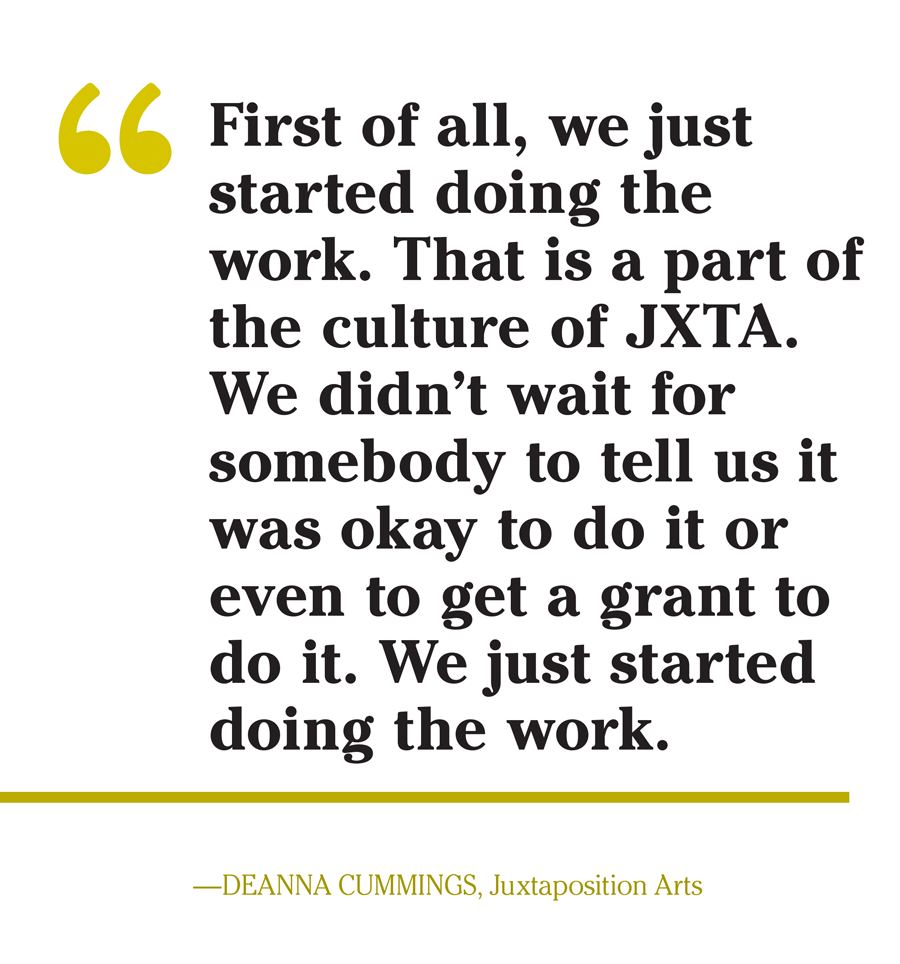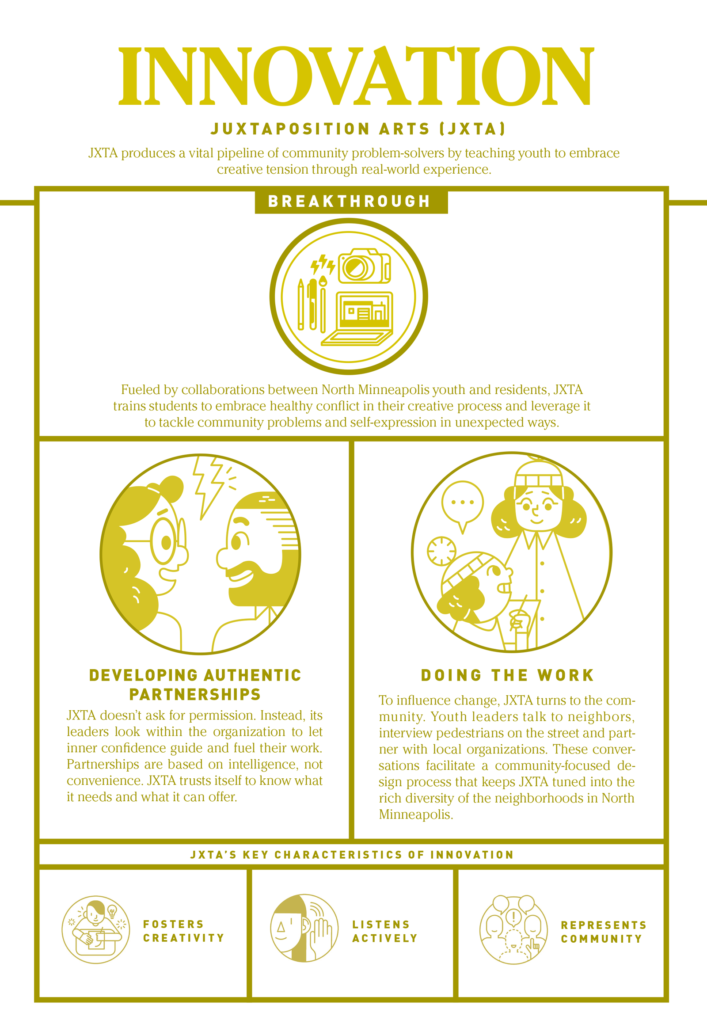
Juxtaposition Arts is a recipient of the Bush Foundation’s Bush Prize for Community Innovation.
Juxtaposition Arts (JXTA) is an education program, teen-staffed design enterprise and locally rooted cultural development center founded in 1995. Since 2005, JXTA has worked with residents and stakeholders toward a vision of improved access to educational, economic and decision-making opportunities that create healthy, beautiful and safe physical environments in the city, with a focus on North Minneapolis.



IF YOU KNOW THE MYERS-BRIGGS TYPE INDICATOR, maybe from charts on Facebook or team-building exercises, then you may find it interesting that the leaders of JXTA are two razor-sharp and strong-willed “Masterminds,” or INTJs. Perhaps due to their like-mindedness, co-directors DeAnna and Roger Cummings, two of the three original JXTA founders, know how to manage conflict as well as cooperation. By tolerating and encouraging conflict, JXTA fosters innovation.

The people who live and work in North Minneapolis are the final voice influencing JXTA’s projects. All public art in their neighborhood is designed to be of benefit. City planning and urban design often involve the destruction of existing buildings, the construction of more expensive ones and gentrification of the area as a result. JXTA rejects that top-down model as a bad fit for the areas where the organization works. To make real change, JXTA involves the community. Simply talking with neighbors goes a long way. JXTA keeps it casual, sending kids to chat with people they meet on the street. The surveys are simple, direct and random, but also strategic—the questions keenly tuned to the rich texture of the neighborhood.
JXTA goes to the community instead of asking the community to come to it, inviting residents and business owners to influence its creative work. For its collaborative project “ReMix: Creating Places for People on West Broadway,” JXTA sent its young artists out with urban planning students to interview pedestrians on sidewalks, at bus stops and in other everyday spaces. They spent hundreds of hours on the street, engaging community members and listening to suggestions and complaints.
Where the community said the streets were poorly lit and uninviting, JXTA built light pole banners and other colorful arts interventions. It also built sculptural benches at high-traffic bus stops in response to the desires of busy parents with kids, groceries and tired legs. Everything JXTA does comes from listening to the community.


This community approach is a much-needed change for the neighborhood. For over 80 years, too many outsiders have dismissed North Minneapolis as a poor area with residents whose interests matter little in public policy decisions. The top-down decisions of government have either neglected the neighborhood or targeted it for development projects that crippled the area. The major highways of I-94 and I-394 that run through Minneapolis cut the neighborhood off from the rest of the city, while the widening of Olson Memorial Highway disrupted a once-thriving business district.
But JXTA is thriving, and North Minneapolis is following its lead. Its success stems from the belief that instead of going outside for help, organizations should start with what they have and who they are. Rather than waiting for some time in the future when it becomes “good enough,” it values what it has and who it is. JXTA knows it’s good enough.
These affirming beliefs constitute the backbone of community-driven projects like ReMix, as well as the personal art of its students and teachers. Confidence in its work and worth allows JXTA to withstand the conflict inherent in creation. It partners intelligently, rather than accepting all deals. JXTA knows itself well enough to know what it offers and what it needs.
Self-knowledge like this is necessary to stand against well-meaning outsiders who primarily think of the area in terms of its economic disparities. DeAnna spoke of a recent partnership request from an arts organization based outside of the North Minneapolis community that wanted to start a project serving at-risk youth in the area. The organization admitted having little insight into the needs of North Minneapolis and sought a collaboration with JXTA because of its close ties with the neighborhood. DeAnna turned the organization down. In her response to the request, she urged the organization to work closer to home, serving the youth in its own community. The knee-jerk association between “North Minneapolis” and “at-risk youth” is an assumption that JXTA consistently fights.



JXTA believes that art and culture are not separate from the people and should be where people are, and it believes that art is for everyone. JXTA originally started as a scrappy little workshop in public housing that grew fast and larger with every grant or project. Some of the founders’ most revolutionary beliefs grew out of their decision to offer the creative outlet they wish they’d had access to as children. It’s not just art for the sake of art though. JXTA’s work is necessarily connected to social and economic justice as well. Situating a creative arts center and gallery in the middle of North Minneapolis was an act of boldness.
JXTA supplies a vital pipeline of community problem-solvers into the lifeblood of the entire metro area. More than half of the students are black, and more than half reside in North Minneapolis, but they represent a broad range of subcultures, interests, gender identities, ethnicities, social classes—even styles of learning and communicating. Not all of them will remain artists, but all retain the confidence and skills JXTA teaches. These students are anything but at-risk youth. They have gone on to study at Harvard and Minneapolis College of Art and Design, intern with architectural firms, work for policy change as part of the government and hold their own art exhibitions.


“That’s what it’s all about,” DeAnna explains. She is proud of her students’ accomplishments and believes that they will lead to people valuing their contributions as experts within their fields, their city, their state and their country. Throughout Minneapolis there is concrete proof of their hard work and talent. Their murals, sculptures and exhibitions depict the enormous value of the people of North Minneapolis. JXTA graduates have a leg up compared to most art students who may receive arts instruction without professional work experience or business skills training. The community engagement in JXTA’s curriculum rounds out its confident and proven artists with creative problem-solving skills that can change the world.
By investing in young people, JXTA challenges the assumption that they can’t impact the world. DeAnna compares JXTA’s students to the young leaders of current and prior civil rights movements. The only people with the energy, exuberance, freedom and optimism to change the world are the young, she explains. In fact, she believes that “nothing really revolutionary has ever happened anywhere without the participation and leadership of young people.”








Produced in partnership with the Bush Foundation
to showcase the culture of innovation
behind its Bush Prize winners.
Contributors




